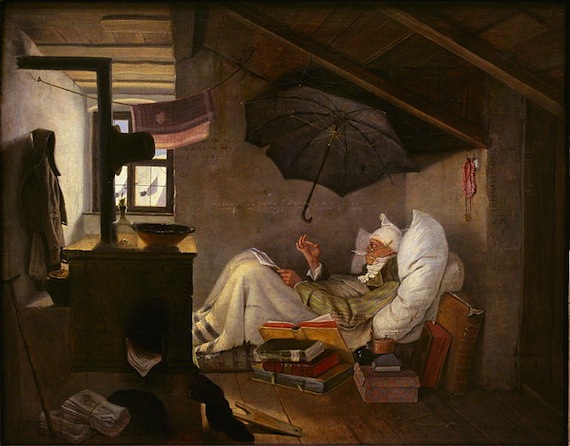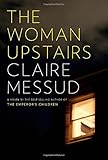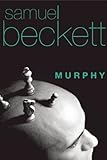
1.
 Albert Parry’s Garrets and Pretenders, the best and most colorful cultural history of Bohemian artists and their “skylight-addicts,” was first published in 1933. Over the intervening 80 years, the coffee shop seems to have displaced the garret as the prime source of real or imagined literary production, but caffeine is no match for the afflatus that drafty garrets provide. As affordable real estate becomes increasingly scarce — and as a new breed of “micro-units” are cropping up in cities — we should pause to reflect back on the enduring appeal of an imperiled genre: the garret novel.
Albert Parry’s Garrets and Pretenders, the best and most colorful cultural history of Bohemian artists and their “skylight-addicts,” was first published in 1933. Over the intervening 80 years, the coffee shop seems to have displaced the garret as the prime source of real or imagined literary production, but caffeine is no match for the afflatus that drafty garrets provide. As affordable real estate becomes increasingly scarce — and as a new breed of “micro-units” are cropping up in cities — we should pause to reflect back on the enduring appeal of an imperiled genre: the garret novel.
 The two classic 19th century examples are Henri Murger’s Scenes from the Life of Bohemia and George du Maurier’s Trilby, which sings of the “happy times of careless impecuniosity” and of artists “with Paris for a playground, and its dear old unregenerate Latin quarter for a workshop and a home!” Ever since, the increasingly fraught search for an ideal room of one’s own has produced surprising variations on the garret novel.
The two classic 19th century examples are Henri Murger’s Scenes from the Life of Bohemia and George du Maurier’s Trilby, which sings of the “happy times of careless impecuniosity” and of artists “with Paris for a playground, and its dear old unregenerate Latin quarter for a workshop and a home!” Ever since, the increasingly fraught search for an ideal room of one’s own has produced surprising variations on the garret novel.
Despite the garret’s military roots as a watchtower from which “to defend, preserve” (from the Old French, garir), our cultural imagination has long associated those cramped quarters less with archers than with easels. And yet the connection between watchtowers and workshops holds. All good art is obsessive, driven by a compulsion to express and shape, and to be obsessed, etymologically, is to be watched closely, occupied, besieged; Samuel Beckett would describe his postwar burst of writing as the “siege in the room.” Both the observant artist and the watchful sentry, then, are each under attack in their garrets, the latter from without and the former from within.
The following garret novels introduce memorably reclusive protagonists, skylight addicts who, in their zealous guarding of their charmed rooms, stay true to the fortifying history of garrets.
2.
 We begin at the last outpost of the garret novel, Claire Messud’s The Woman Upstairs, the romanticizing, embattled heroine of which, likeable or not, galvanizes the genre.
We begin at the last outpost of the garret novel, Claire Messud’s The Woman Upstairs, the romanticizing, embattled heroine of which, likeable or not, galvanizes the genre.
Two female artists, Sirena and Nora, the former internationally renowned and constructing a sprawling installation entitled “Wonderland,” the latter a schoolteacher and artist manqué building dioramas of Emily Dickinson, Virginia Woolf, Alice Neel, and Edie Sedgwick in their own “habitats,” agree to share a workshop in a converted Somerville warehouse. The studio is enclosed by a “high chicken-wire fence, in which fluttered the tattered remnants of plastic bags, like flags of the apocalypse.” The insides are of a “bleakness unimagined,” and next door is a factory producing “millions of tiny Styrofoam beads, a particularly noxious undertaking that seemed designed to cause horrible cancers in those who worked there.” There is a mephitic whiff of the demonic about the place that renders the women’s artistic Eden as ripe for corruption as was Adam and Eve’s.
The workshop, at once pestilent and beatific, ultimately teaches Nora a painful but productive lesson: creation and “fouling” are intertwined. Indeed, each woman’s project is an attempt to recreate private worlds even as it exposes them to view. If the studio is a retreat from the world — Sirena’s husband likens it to an elves’ workshop — it finally launches Nora into it, no longer as “the woman upstairs” but as a “murderously furious” artist intent to “fucking well live.”
 In Danilo Kiš’s The Attic, we encounter the garret novel in its purest, uncorrupted form:
In Danilo Kiš’s The Attic, we encounter the garret novel in its purest, uncorrupted form:
Hic tandem stetimus nobis ubi defuit orbis. (“Here we finally stand, a place that has fled our earth.”)
So reads the maxim carved into a wall of the titular attic in this enchanting Serbian work. Kiš’s first novel, an English translation of which appeared last year from Dalkey Archive Press, is about a young writer, Orpheus, who is “bound to [his] attic by an unusual, sick passion.” Orpheus devises a site-specific cocktail, “Brandy à la Mansarde,” tames the garret’s legion cockroaches with his lute playing, and sees on its damp walls “wondrous designs of the flora and fauna that bloom and thrive only in dreams.” Who needs an interior decorator amidst such fecund rot?
Among the Belgrade garret’s other advantages, for example a “proximity to the stars,” Kiš stresses its inviolability: “Lord, I’ve been living in that attic as if on another planet!” the protagonist realizes at novel’s end. The Attic is a parody of both the bildungsroman and the classic Bohemian novels of the 19th century, dramatizing as it does the protagonist’s growing awareness of the need to descend from his empyrean heights. For him and his art to mature, he must lower himself, literally, into the world and observe his fellow apartment dwellers rather than the stars.
Orpheus’s dilemma — whether to reign hermetically in his aerie or participate in the “colorful jumble of life” — demonstrates a crucial tension in all novels between a reclusive and an expansive drive; between a retreat into a world of private obsessions and a headlong rush into the great wide world.
 Nowhere is this tension more amusingly expressed than with the misadventures of Murphy, Samuel Beckett’s doomed garretphile. Murphy, itself a parodic bildungsroman, chronicles one man’s doomed quest to separate himself from the “big blooming buzzing confusion” around him, a quest that is thwarted — comically and tragically — by the decidedly un-Murphy-like characters around him. That quest is bound up with the anti-hero’s search for the ideal garret. Ever since residing in a Hanover garret as a student, Murphy has been searching for similarly charmed living quarters. However, “what passed for a garret in Great Britain and Ireland was really nothing more than an attic. An attic! How was it possible for such a confusion to arise?” When he stumbles into a job at the Magdalen Mental Mercy seat asylum in London, he is less excited about the prospects of steady employment than his new living quarters: not an “attic, nor yet a mansard, but a genuine garret.”
Nowhere is this tension more amusingly expressed than with the misadventures of Murphy, Samuel Beckett’s doomed garretphile. Murphy, itself a parodic bildungsroman, chronicles one man’s doomed quest to separate himself from the “big blooming buzzing confusion” around him, a quest that is thwarted — comically and tragically — by the decidedly un-Murphy-like characters around him. That quest is bound up with the anti-hero’s search for the ideal garret. Ever since residing in a Hanover garret as a student, Murphy has been searching for similarly charmed living quarters. However, “what passed for a garret in Great Britain and Ireland was really nothing more than an attic. An attic! How was it possible for such a confusion to arise?” When he stumbles into a job at the Magdalen Mental Mercy seat asylum in London, he is less excited about the prospects of steady employment than his new living quarters: not an “attic, nor yet a mansard, but a genuine garret.”
Paradise at last, it seems, but this is Beckett we’re talking about. The protagonist’s inevitable and explosive demise arises from a faulty gas pipe extending into his garret, a noxious violation of his Edenic space (or the fouling of his Wonderland, to put it in Messud’s terms), the perfect garret he had long sought and finally found. For Beckett, the possibility of establishing such an inviolate cell within the “mercantile Gehenna” of London proves as illusory as Godot’s arrival.
 The protagonist of John Cowper Powys’s Maiden Castle, Dud No-man seems as immune to the demands of social life as Murphy. Maiden Castle opens as No-man, a “nameless bastard” and widowed historical novelist, looks up from his bed in his new Dorchester garret and finds that the beams “took the shape…of an elongated and distorted cross.” The rest of the furnishings are similarly charged with its owner’s intensely cerebral, masochistic eroticism and diabolical grotesquerie — martyrs, condemnatory wraiths, and monstrous heraldic carvings. As most Powys heroes do, No-man thrives on such daemonic energies. His garret, with its view of a “region charged with so many layers of suggestive antiquity,” stimulates his historical, psychological, and elemental senses as he writes the erotically charged tale of Mary Channing, the adulteress hanged in 1705 in the nearby Maumbury Rings amphitheatre for allegedly poisoning her husband.
The protagonist of John Cowper Powys’s Maiden Castle, Dud No-man seems as immune to the demands of social life as Murphy. Maiden Castle opens as No-man, a “nameless bastard” and widowed historical novelist, looks up from his bed in his new Dorchester garret and finds that the beams “took the shape…of an elongated and distorted cross.” The rest of the furnishings are similarly charged with its owner’s intensely cerebral, masochistic eroticism and diabolical grotesquerie — martyrs, condemnatory wraiths, and monstrous heraldic carvings. As most Powys heroes do, No-man thrives on such daemonic energies. His garret, with its view of a “region charged with so many layers of suggestive antiquity,” stimulates his historical, psychological, and elemental senses as he writes the erotically charged tale of Mary Channing, the adulteress hanged in 1705 in the nearby Maumbury Rings amphitheatre for allegedly poisoning her husband.
The novel’s conflict derives not from within the spiritually magnetic garret but from without. Maiden Castle is about a man with an intense attachment to solitary enjoyment — sexual, oneiric, imaginative, ambulatory, and masochistic — who is drawn into the very set of social, filial, and romantic relationships from which his intense egotism had so long protected him. But again, the developmental narrative can’t gain traction within the psychically saturated world of the novel’s protagonist. No-man, who describes himself as a “Bronze Age invader” with the soul of a “neurotic nun,” proves ultimately too bizarre, too attached to his garret and environs, to become anything other than what he is.
 It would be quite the feat to out-cathect Dud No-man, but Godfrey St. Peter comes close in his attachment to his garret study in Willa Cather’s The Professor’s House. Throughout the novel, St. Peter is exhausted by the professional and familial responsibilities he is too moral to shirk. His malaise obliquely stems from his memories of the “richly germinating” Tom Outland, the deceased student, amateur archeologist, and inventor who had appeared at the Professor’s house years earlier with tales of excavating an Ancestral Puebloan settlement, Cliff City, perched atop the Blue Mesa (a fictionalized Mesa Verde).
It would be quite the feat to out-cathect Dud No-man, but Godfrey St. Peter comes close in his attachment to his garret study in Willa Cather’s The Professor’s House. Throughout the novel, St. Peter is exhausted by the professional and familial responsibilities he is too moral to shirk. His malaise obliquely stems from his memories of the “richly germinating” Tom Outland, the deceased student, amateur archeologist, and inventor who had appeared at the Professor’s house years earlier with tales of excavating an Ancestral Puebloan settlement, Cliff City, perched atop the Blue Mesa (a fictionalized Mesa Verde).
The Professor’s House opens as St. Peter is reluctant to move into a new and garret-less house. Despite being “the most inconvenient study a man could have,” it is not without its charms. The attic has a distant view of “a long, blue, hazy smear—Lake Michigan, the inland sea of his childhood,” an idyllic framing that blends into Tom Outland’s similarly hued Blue Mesa. As the Professor lets Outland into his study (to the jealous disapproval of his wife), so does Outland admit the Professor to his elevated sanctuary and shares with him that “glorious feeling…of being on the mesa, in a world above the world.”
If The Professor’s House is dominated by these elevations — Cliff City and the less sublime attic — it is also about the pain of being expelled from them. Both the mesa and the attic are prone to contamination, by a disillusioning commercialization or by (yet another) noxious gas leak. Of all the works, Cather’s is the most elegiac in tone. It best captures the vulnerability of such precious spaces, the pathos of sacrificing them and learning to “live without delight.”
 The previous garret novels have staged a struggle between isolation and inclusion, but Thomas Bernhard’s Correction boldly and unequivocally asserts a reclusive vision. As his protagonist, Roithamer, epigrammatically explains: “What we do secretly, succeeds.” A scientist, Roithamer embarks on an architectural project whose audacity would make Howard Roark blanche: a giant Cone in the exact center of the Kobernausser forest (supposedly designed to ensure the perfect happiness of his sister). Roithamer secretly plans the construction from within the garret of an equally audacious project, a house built by his friend Hoeller in “the most impenetrable and so the darkest possible” section of the Aurach gorge. The builder takes possession of Hoeller’s garret so completely that it soon becomes Roithamer’s garret and infused with his thoughts. After the Cone’s completion and Roithamer’s suicide, the unnamed narrator himself takes possession of the garret and undergoes a kind of siege himself, possessed by its Hoeller-garret-thoughts, a Germanic compound noun so mellifluous that it is a small wonder it hasn’t yet gone viral.
The previous garret novels have staged a struggle between isolation and inclusion, but Thomas Bernhard’s Correction boldly and unequivocally asserts a reclusive vision. As his protagonist, Roithamer, epigrammatically explains: “What we do secretly, succeeds.” A scientist, Roithamer embarks on an architectural project whose audacity would make Howard Roark blanche: a giant Cone in the exact center of the Kobernausser forest (supposedly designed to ensure the perfect happiness of his sister). Roithamer secretly plans the construction from within the garret of an equally audacious project, a house built by his friend Hoeller in “the most impenetrable and so the darkest possible” section of the Aurach gorge. The builder takes possession of Hoeller’s garret so completely that it soon becomes Roithamer’s garret and infused with his thoughts. After the Cone’s completion and Roithamer’s suicide, the unnamed narrator himself takes possession of the garret and undergoes a kind of siege himself, possessed by its Hoeller-garret-thoughts, a Germanic compound noun so mellifluous that it is a small wonder it hasn’t yet gone viral.
At one point, Roithamer calls humans “chronic deserters of original ideas,” a definition of mankind as elegant as it is rueful. The Cone, monstrous in its perfection, is one such original idea, and as such demands a kind of desertion from life. Roithamer wholeheartedly embraces the terror and splendor of isolation, the dreadful necessity to “be absolutely alone in our room” in order to experience the supreme, if awful, majesty of inhabiting a world of one’s own making.
 If I have focused too much on the obsessive aspects of garret-thoughts (there’s that Germanic construction again), let me remedy that with a brief demonstration of their conjuring power. In Mervyn Peake’s Titus Groan, Gormenghast Castle’s forbidding stone walls virtually seal its inhabitants into a world of “iron ritual.” However, Fuchsia, the reclusive daughter of the castle’s lord, manages to carve out her own “attic kingdom” from within the stony realm, a “world undesecrate” that she fills with imaginary characters:
If I have focused too much on the obsessive aspects of garret-thoughts (there’s that Germanic construction again), let me remedy that with a brief demonstration of their conjuring power. In Mervyn Peake’s Titus Groan, Gormenghast Castle’s forbidding stone walls virtually seal its inhabitants into a world of “iron ritual.” However, Fuchsia, the reclusive daughter of the castle’s lord, manages to carve out her own “attic kingdom” from within the stony realm, a “world undesecrate” that she fills with imaginary characters:
This was the loft which was for Fuchsia a very secret place, a kind of pagan chapel, an eyrie, a citadel, a kingdom never mentioned, for that would have been a breach of faith — a kind of blasphemy.
It is this wondrous element — secretive, reverential, mythic — that best explains why the garret is so treasured and fiercely guarded by their visionary inhabitants, who devise dreamscapes from within the elevated confines that rival the awesome landscapes without: private Wonderlands, the mystical Dorchester ruins, the sublime darkness of the Aurach gorge, and the richly “germinating” intimations of Cliff City.
Image Credit: Wikipedia








